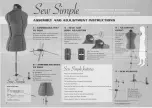
Client:
ALDI Australia
Project:
Lumina ESM 008
Language:
EN
Barcode: 930 5026 10 000 3 00151
12
Date:
25.09.2007
Version: 02
Page:
12
(of 40 pages)
OPERATION
Winding
The numbering on the figure corresponds to the following work steps:
1. Pull the hand wheel (23) outwards, in order to break contact. Now the
needle does not move anymore if you turn the hand wheel.
2. Guide the thread from the thread spool through the winding tension
disc (9).
3. Guide the thread from the inside through one of the small openings of
the bobbin and place the bobbin onto the bobbin supporting arm (11).
4. Press the bobbin to the right against the bobbin case (12).
5. Hold the thread end tight, and slightly press the foot pedal.
Stop after the thread has wound itself several times round the bobbin.
Cut off the surmounting thread end directly in front of the bobbin.
Again press the foot pedal and wind the thread until the bobbin is
filled.
The machine will stop automatically.
6. Now press the bobbin supporting arm (11) to the left and cut off the
thread.
7. Push the hand wheel (23) to the inside (into starting position), in order
to reactivate contact.
















































